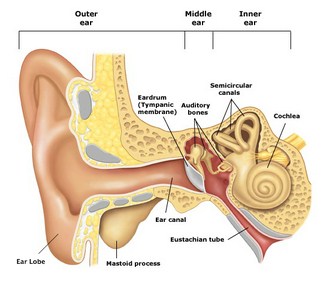
It is present between tympanic membrane and oval window of inner ear. It is an air filled cavity. The tympanic membrane vibrates in the same frequency as sound waves. When transmission of sound wave stops, the vibration of tympanic membrane also stops and hence the tympanic membrane is critically damped. The tympanic membrane is connected to the oval window by three ossicles namely malleus, incus and stapes. The handle of malleus is attached to the tympanic membrane and its head articulates with the head of incus. The handle of incus articulates with the head of stapes. The foot plate of stapes ends on the oval window.
The middle ear is connected to nasopharynx through the eustachian tube. Its opening in the nasophrynx is narrow and closed normally, except during swallowing, chewing, yawning, sneezing and vocalization. The opening of eustachian tube in nasopharynx facilitates equalisation of pressure on both sides of the tympanic membrane. This is disturbed during aeroplane ascent and descent, when the ambient pressure is different from atmospheric pressure. The unequal pressure on both sides of the tympanic membrane causes its bulging, producing pain. Relief from this can occur by swallowing fluid or chewing. The eustachian tube also helps to drain fluid into nasopharynx, which accumulates in the middle ear, as a consequence of infection. It is common in children to observe throat infection spreading to middle ear through the eustachian tube. The bulging of eardrum due to the accumulation of fluid causes pain and sometimes it can cause due to tearing of eardrum also can occur. There are two striated muscles in the middle ear namely tensor tympani and stapedius.These muscles are supplied by V and VII cranial nerves respectively. Whenever, there is a loud sound, these muscles reflexly contract and attenuate the sound intensity to protect the auditory receptors. The reflex contraction of middle ear muscles due to loud sound is called acoustic reflex. The contraction of tensor tympani pulls the tympanic membrane inwards and contraction of stapedius pulls foot plate of stapes out of the oval window.
This mechanism is responsible for the attenuation of sound intensity. This protctive reflex is not useful, when there is a loud sound instantly produced, as in gunshots. The reason is due to the time lag between the loud sound produced and reflex contraction of middle ear muscles. It has been observed that middle ear muscles contract to one’s own loud speech. This reflex contraction helps the individual to hear his own speech and facilitates meaningful communication.
Source: Textbook of Physiology, 3E (Chandramouli) (2010)